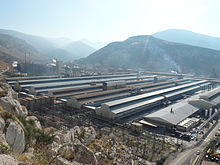Aluminum de Grece
| Aluminum de Grèce (Αλουμίνιο της Ελλάδος) |
|
|---|---|
| legal form | Corporation |
| ISIN | GRS081103004 |
| founding | 1960 |
| Seat |
Marousi , Greece |
| management |
|
| Number of employees | 1,550 (2014) |
| sales | EUR 720 million (2014) |
| Branch | raw materials |
| Website | www.alhellas.gr |
Aluminum de Grèce ( Greek Αλουμίνιο της Ελλάδος ; English : Aluminum of Greece) is a Greek aluminum manufacturer . The company was founded in 1960 as a cooperation between the French aluminum manufacturer Pechiney , the Greek company M. Niarchos , the Greek Bank for Industrial Development ( Greek Ελληνική Τράπεζα Βιομηχανικής Ανάπτυξης pour ) and the American aluminum manufacturer Reynolds MetalsAD l'Etagnie et al Developpement des Echanges Commerciaux). The company is based in the Athens suburb of Marousi .
The factory is located in Agios Nikolaos near Distomo in Boeotia on the north coast of the Gulf of Corinth . This location is characterized by the proximity to the rich bauxite deposits in Boeotia and Fokida and the excellent connection to the sea. The factory's annual production capacity is 800,000 tons of aluminum oxide and 164,000 tons of aluminum. 1,100 of the employees are employed in production. The company also owns the port of Agios Nikolaos, where ships with a load capacity of up to 40,000 tons can handle cargo.
Aluminum de Grèce has been listed on the Athens Stock Exchange as a public limited company since 1973 . It has been part of the Mytilineos Holdings group since 2005 . The Delphi-Distomon Mining Company is also part of the group.
Construction of the factory
Originally it was considered to build the factory in the Gulf of Itea . However, since many tourists landed here by ship on their way to Delphi , they looked for another location. The coast south of the ancient city of Medeon appeared ideal . The valley between the mountains offered enough space for a large factory. In addition, the place lies between the two large bauxite deposits in the Helikon and the Parnassus . The seabed drops off steeply on the coast, so that a harbor for large ships could be built there.
Before it was built, the valley was archaeologically examined by the École française d'Athènes . Roman, Byzantine and Venetian ruins were found here, which are now hidden under the factory. When a new road was being built, numerous ancient tombs were discovered about 300 m northwest of today's factory. In Aspra Spitia , about 3.5 km to the north-west, housing for 3,000–4,000 people was built for employees and their families. Since the production of aluminum is electricity-intensive, two new hydropower plants were also built. The Plastiras reservoir was completed in 1962 and the Kremasta reservoir in 1969.
The factory was put into operation on February 11, 1966. At that time it was the most modern aluminum factory in Europe. The factory's annual production capacity was 200,000 tons of aluminum oxide and 72,000 tons of aluminum. Greece moved up to 6th place among European aluminum producers. The extraction of aluminum from bauxite takes place in two steps. First, the bauxite is converted into aluminum oxide using the Bayer process . Then metallic aluminum is obtained by fused- salt electrolysis in the Hall-Héroult process .
Individual evidence
- ↑ Home Page of Aluminum of Greece: Products
- ^ Homepage of Aluminum of Greece: Infrastructure
- ^ Homepage of Aluminum of Greece: History Time Line
- ^ Monique Chassaing: Le complexe industriel d'aluminium de Grèce . In: Méditerranée . tape 7 , no. 4 , 1966, pp. 295-311 ( [1] ).
Web links
Coordinates: 38 ° 21 ′ 40 " N , 22 ° 41 ′ 30" E
